When it comes to Greek comfort food, few dishes steal the spotlight like moussaka. Rich, hearty, and irresistibly satisfying, moussaka is a layered casserole dish made with eggplant, savory meat sauce, and a dreamy béchamel topping. This Mediterranean classic has wowed taste buds for generations, and once you try it, you’ll see why!
In this guide, we’ll walk you through everything you need to know about preparing a truly authentic moussaka recipe. From its fascinating origins to step-by-step cooking instructions, dietary tweaks, and FAQs, we’re covering it all. Whether you’re a seasoned home cook or trying this dish for the first time, you’re in for a treat.
Let’s dive into the delicious world of Greek eggplant bakes!
Introduction to Moussaka
The Origins of Moussaka
Moussaka may be known as a Greek classic, but its roots stretch far across the Mediterranean and Middle East. Some food historians trace its origins back to Arab cuisine, where eggplant-based dishes were common long before they reached European shores. Over time, moussaka evolved into the beloved layered casserole we know today, especially in Greece, where it’s become a national treasure.
The Greek version we’re highlighting in this moussaka recipe typically includes layers of fried or roasted eggplant, a seasoned ground meat filling (usually lamb or beef), and a thick, velvety béchamel sauce. It’s then baked until bubbling and golden. Sound like a showstopper? It absolutely is.
Moussaka’s Place in Greek Cuisine
In Greece, moussaka isn’t just a meal; it’s a celebration of family, tradition, and the Mediterranean way of life. Often served at gatherings, holidays, or Sunday dinners, this dish is a labor of love that’s well worth the effort.
It’s rich, warm, and full of flavors that transport you straight to a cozy Greek taverna. And while it’s easy to mistake it for lasagna or shepherd’s pie, moussaka has its own bold identity, thanks to aromatic spices, eggplant layers, and that signature béchamel crown.
Ready to start cooking? Let’s break down the essential ingredients next.
Essential Ingredients for Traditional Moussaka
Eggplants: Selection and Preparation
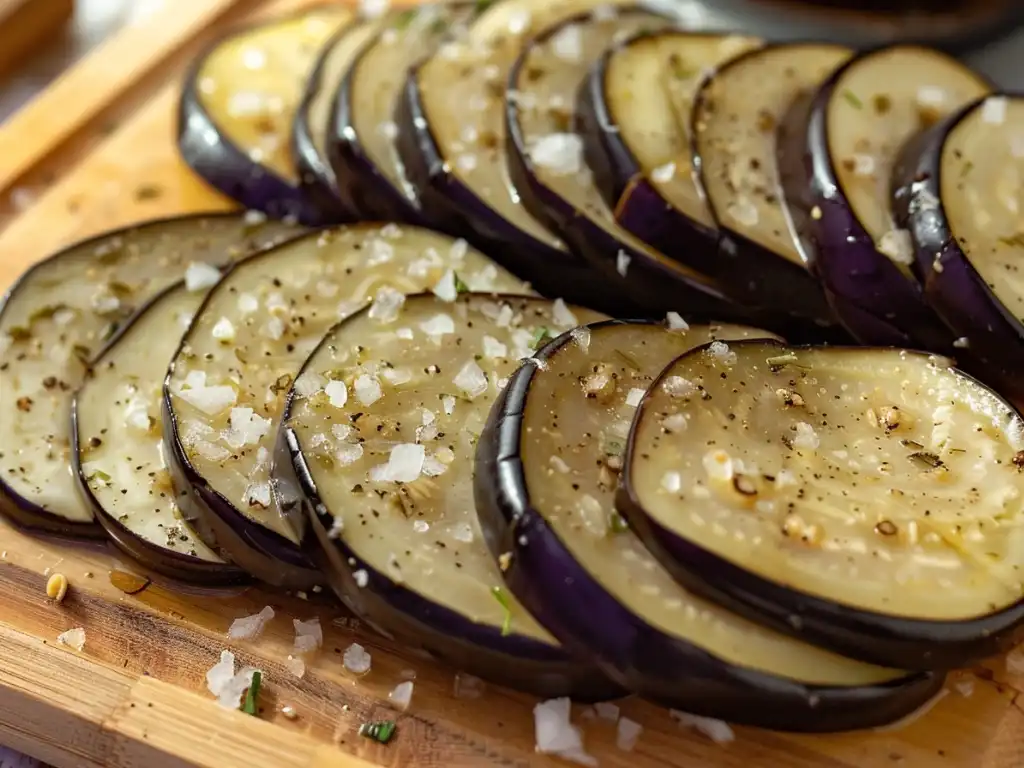
Eggplant is the heart and soul of any authentic moussaka recipe. For that perfect melt-in-your-mouth texture, choose firm, glossy eggplants, preferably the large, dark purple kind. They hold their shape well and soak up all those rich flavors beautifully.
Before anything else, slice them about ½ inch thick and sprinkle with salt. This draws out bitterness and extra moisture. After about 20–30 minutes, pat them dry. From there, you can either pan-fry or roast them. Roasting is lighter and just as tasty, plus it keeps the layers from getting too oily later on.
Ground Meat: Lamb vs. Beef
Traditionally, Greek moussaka uses ground lamb, which has a deep, slightly gamey flavor. But if lamb’s not your thing or you want something a little milder, ground beef works wonderfully too. Either way, the key is to cook it down with onion, garlic, Mediterranean spices like cinnamon and allspice, and a splash of red wine or tomato sauce for depth.
Prefer using ground beef over lamb in your moussaka? You’re not alone! Ground beef offers a milder taste and is often more accessible. If you’re looking to expand your recipe rotation with more comforting beef dishes, don’t miss our 10 Easy Beef Recipes for Busy Weeknights. From skillet favorites to hearty oven bakes, it’s full of inspiration for every busy home cook.
Potatoes: To Include or Not?
Now, here’s where things get interesting. Some versions of the moussaka recipe include a layer of sliced, pre-cooked potatoes at the base. It adds a comforting, starchy bite, but it’s totally optional. If you’re going full traditional, skip them. If you’re after a more filling dish, go ahead and layer them in!
The Signature Béchamel Sauce
h, the béchamel: creamy, silky, and totally essential. Made from butter, flour, milk, and a dash of nutmeg, this topping turns your Greek casserole into a showstopper. For extra richness, many Greek cooks stir in egg yolks or grated cheese like Kefalotyri or Parmesan.
Traditional Greek moussaka recipes often use Kefalotyri, a salty, hard cheese made from sheep or goat’s milk. Learn more about Kefalotyri cheese here , its sharp flavor brings depth to the creamy béchamel layer.
Aromatic Herbs and Spices
What truly brings this dish to life? The herbs and spices, no doubt. Think oregano, thyme, cinnamon, and bay leaf. These add warmth and depth to the meat sauce, making your homemade moussaka taste like it came straight from a Greek taverna.
Preparing the Components
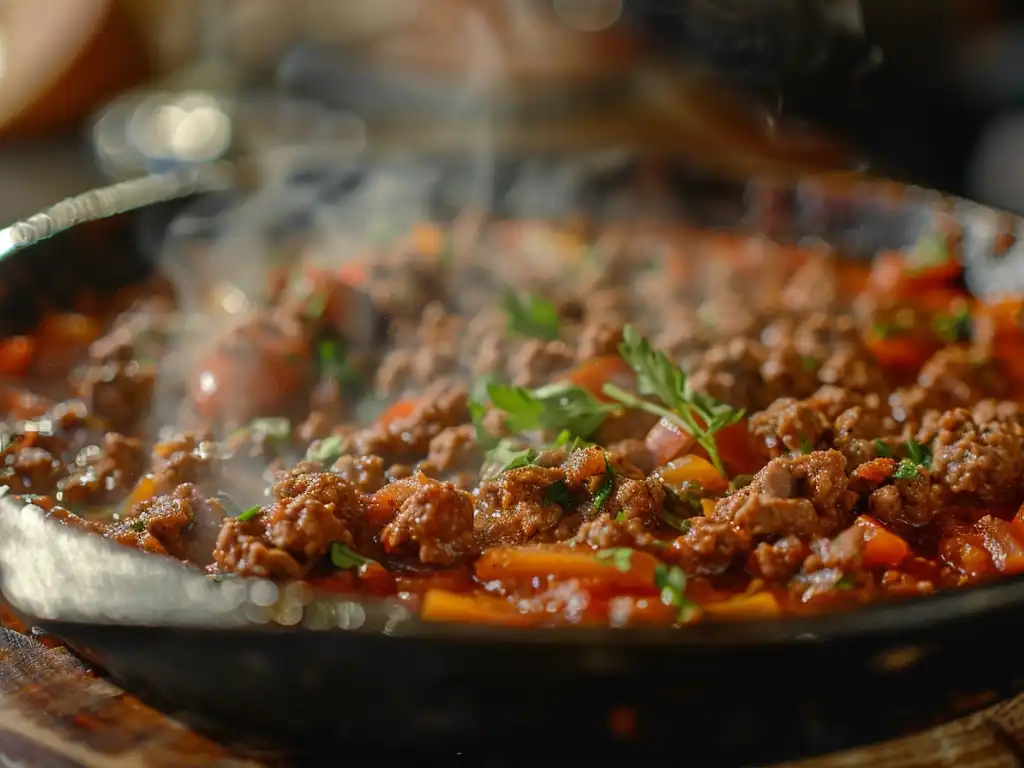
Slicing and Cooking the Eggplants
Alright, first things first: let’s get those eggplants ready. After you’ve salted and dried them, arrange the slices on a baking sheet and brush with olive oil. Roast at 400°F (200°C) for about 20 to 25 minutes, flipping halfway through. They should be golden, tender, and slightly caramelized. This step is crucial; it gives your moussaka recipe that deep, roasted flavor without making it greasy.
Alternatively, you can pan-fry them if you’re after that classic indulgent texture. Just keep an eye on the oil; eggplants soak it up like sponges!
Crafting the Rich Meat Sauce
While the eggplants are roasting, let’s build that savory meat sauce. Start by sautéing chopped onions and garlic in olive oil until soft and fragrant. Add your ground meat, lamb or beef, and cook until browned. Then, toss in tomato paste, a splash of red wine (optional but oh so good), and crushed tomatoes.
Now for the magic: stir in cinnamon, allspice, oregano, and a pinch of sugar. Simmer it low and slow for 20–30 minutes. You want a thick, bold sauce packed with Mediterranean flavors. This is the base that sets your Greek eggplant casserole apart.
Perfecting the Creamy Béchamel
Next up, the crown jewel: béchamel sauce. In a saucepan, melt butter and whisk in flour to form a roux. Slowly add warm milk, whisking constantly to avoid lumps. Keep stirring until the sauce thickens into a creamy consistency.
To finish, stir in grated cheese (like Parmesan), salt, white pepper, and a touch of nutmeg. For a traditional touch, whisk in one or two egg yolks off the heat. This gives the béchamel a rich, custardy texture that bakes up beautifully golden.
Optional: Preparing Potato Layers
If you’re going the extra mile with potatoes, peel and slice them into ¼-inch rounds. Boil until just tender, not mushy! You can also roast or lightly fry them, depending on how crispy you want the bottom layer to be. This adds another level of comfort to your layered meat and vegetable bake.
With all the parts prepped, you’re now just a few steps away from creating the ultimate moussaka recipe. Next up: the grand assembly!
Assembling and Baking the Moussaka
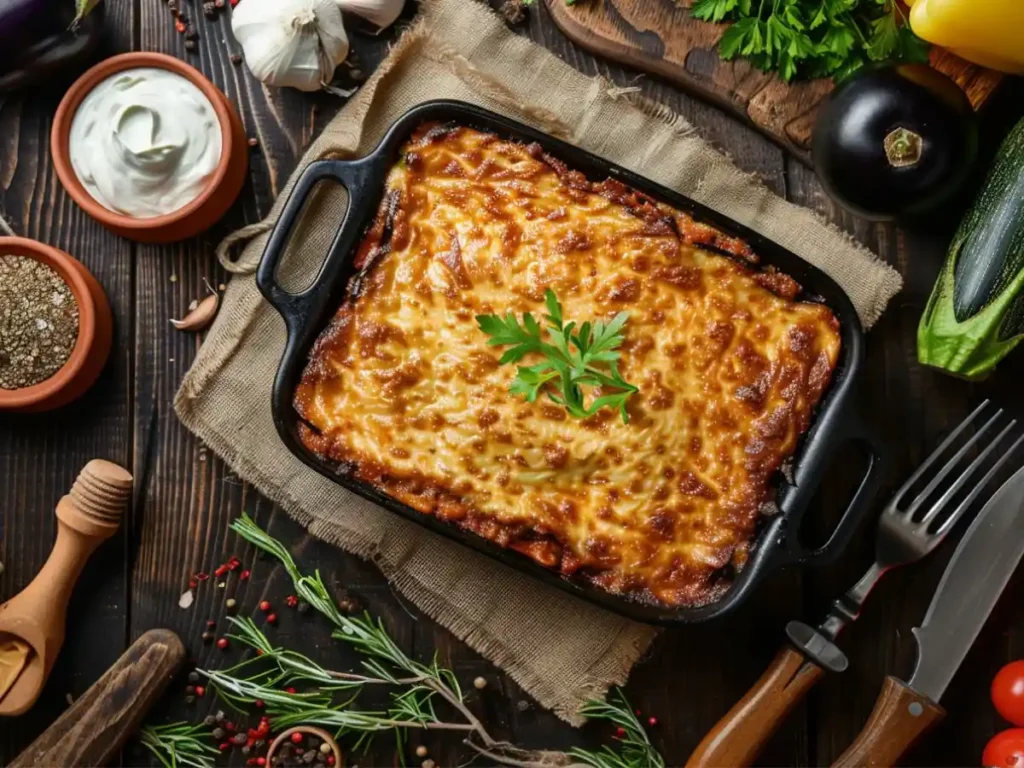
Layering the Ingredients
Now comes the fun part: putting everything together. Grab a large baking dish (9×13 inches works great) and lightly grease it. If you’re using potatoes, lay them down first to create a starchy base layer.
Next, add a single layer of roasted eggplant slices, followed by a generous portion of your savory meat sauce. Spread it evenly. Repeat the layering: eggplant, meat sauce, until you’ve used everything up. Finally, pour the creamy béchamel sauce over the top, spreading it edge to edge like frosting on a cake.
For extra flavor and a golden top, sprinkle a bit of grated cheese or breadcrumbs over the béchamel.
Achieving the Ideal Thickness
One of the secrets to a great moussaka recipe is the thickness of each layer. Keep the béchamel thicker than you think; it acts as a rich cap and balances the robust meat and eggplant below. Your final dish should be at least 2 inches thick, if not more. This gives it that classic look and satisfying forkful every time.
Baking to Golden Perfection
Preheat your oven to 375°F (190°C) and bake uncovered for 45 to 50 minutes. Keep an eye on the top; it should turn a beautiful golden brown and bubble slightly around the edges.
Let it rest for 20 to 30 minutes after baking. Trust us, this step makes slicing neater and allows the flavors to settle. And that’s it, you’ve just baked an authentic Greek moussaka like a pro.
Love the cozy, layered nature of moussaka? Then you’ll definitely appreciate the comfort of baked casseroles. For more inspiration, take a look at our Ultimate Chicken Casserole Recipes Guide. It’s packed with creative, satisfying chicken bakes perfect for weeknight dinners or make-ahead meals.
Variations and Dietary Adaptations
Vegetarian and Vegan Alternatives
Good news: moussaka isn’t just for meat lovers. If you’re vegetarian or vegan, you can still enjoy this dish in all its layered glory. Swap out the ground meat with lentils, mushrooms, or a plant-based alternative. These add that same rich texture without compromising flavor.
For the béchamel, go dairy-free by using plant-based milk, vegan butter, and a touch of flour. Nutritional yeast adds that cheesy vibe without the cheese. It’s still creamy, dreamy, and absolutely satisfying.
Gluten-Free and Low-Carb Options
Need a gluten-free twist? No problem! Just replace regular flour in the béchamel with rice flour or cornstarch; it thickens just as well. For a low-carb version, skip the potatoes altogether and use more eggplant or even zucchini. You’ll still get that layered vegetable bake experience with fewer carbs.
Some creative foodies even swap in cauliflower slices or cabbage leaves for something totally out-of-the-box. Honestly, there’s no limit to how you can tweak this moussaka recipe to fit your dietary needs.
Regional Twists on the Classic Recipe
Did you know that different regions have their own spins on Greek moussaka? In Turkey, a version called “musakka” is prepared stovetop without béchamel. Meanwhile, Balkan countries like Serbia and Bulgaria often add carrots or red bell peppers to the mix.
You might even stumble across versions using zucchini, chickpeas, or topping it with yogurt instead of sauce. The result? A beautiful variety of flavors all rooted in that same love for Mediterranean cuisine.
Up next, let’s talk serving tips and pairings!
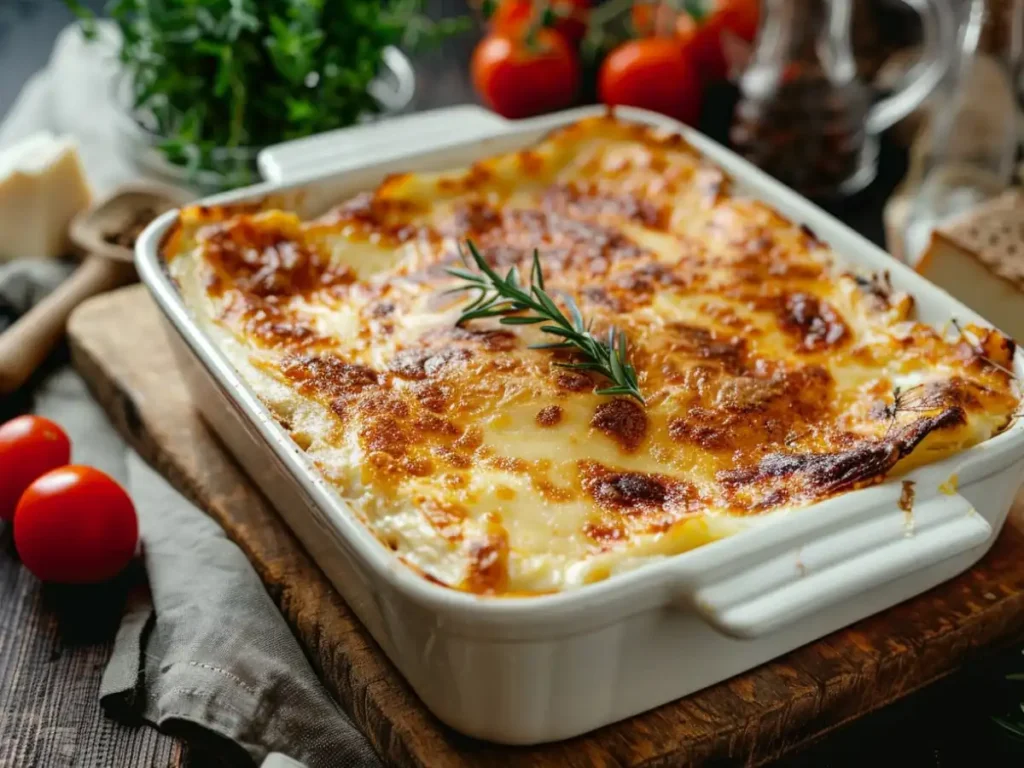
Serving and Pairing Suggestions
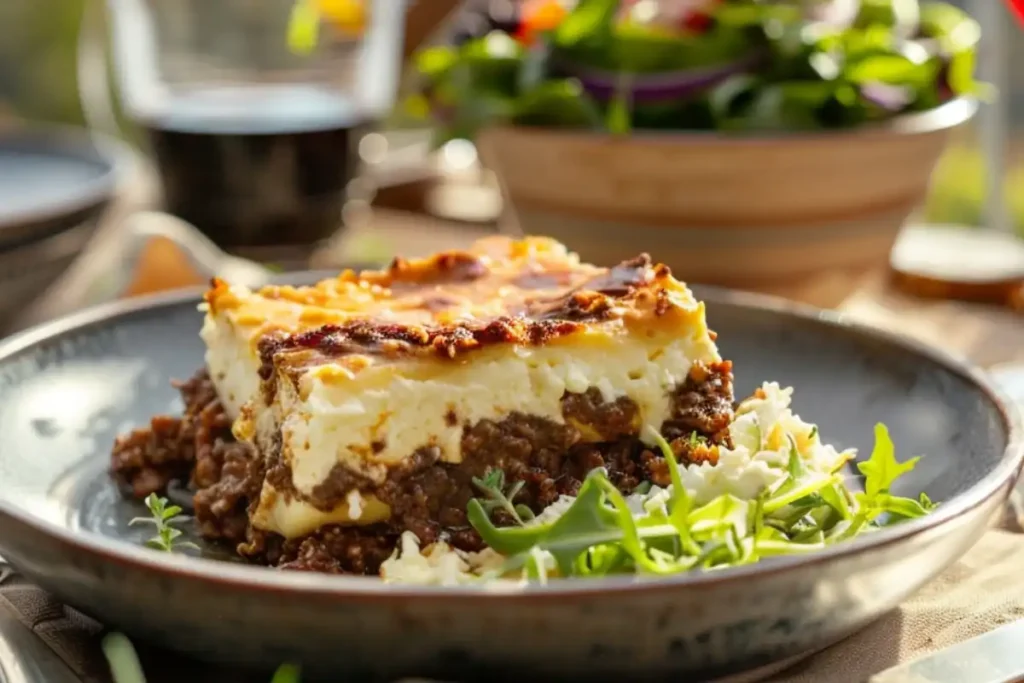
Ideal Side Dishes and Salads
Once your moussaka recipe is baked to golden perfection, it’s time to plate it up with some tasty sides. Because this dish is rich and hearty, lighter sides really hit the mark. A crisp Greek salad with cucumber, tomato, olives, and feta adds a cool, tangy contrast that refreshes your palate between bites.
Alternatively, a simple cucumber-yogurt dip like tzatziki is a fantastic pairing. It cuts through the richness and brings a refreshing, herby note to the meal. You could also serve it with crusty bread to soak up all that saucy goodness, or go gluten-free with roasted vegetables or a citrusy quinoa salad.
Frequently Asked Questions About Moussaka
Can Moussaka Be Made Ahead of Time?
Absolutely! One of the best things about this moussaka recipe is that it’s ideal for make-ahead meals. You can prep the layers, assemble the dish, and refrigerate it (uncooked) for up to 24 hours. When you’re ready, just pop it in the oven.
How to Store and Reheat Leftovers?
Leftover moussaka stores well in the fridge for 3 to 4 days. Be sure to cover it tightly or use an airtight container. To reheat, warm it in the oven at 350°F (175°C) until hot throughout. This keeps the layers crisp and the béchamel from getting soggy.
What is the origin of moussaka?
Moussaka is a layered eggplant dish popular in Greece, but its roots can be traced to the Middle East. Over time, it evolved into the well-known Greek version we love today, complete with eggplant, meat sauce, and béchamel.
Can I make moussaka without eggplant?
Yes, you can! While eggplant is traditional, many variations use zucchini or even potatoes. These keep the structure while offering a different taste and texture. It’s a fun way to switch up your moussaka recipe.
How do I prevent my moussaka from being watery?
The key is to salt and roast the eggplant properly before layering. Also, make sure your meat sauce is thick and not too runny. These steps help maintain structure and flavor.
Is it possible to make moussaka ahead of time?
Definitely. You can assemble the dish a day in advance and refrigerate it. This actually helps the flavors blend better. When ready, bake it fresh for best results.
What are the best side dishes to serve with moussaka?
A crisp Greek salad, roasted veggies, or even lemon potatoes make excellent sides. Lighter dishes balance the richness of a hearty moussaka recipe beautifully.
Tips for Freezing Moussaka
Freezing your moussaka? You bet. It’s best to freeze it after baking. Let it cool completely, then wrap portions tightly with foil or plastic wrap and store in a freezer-safe bag. Reheat directly from frozen, or let it thaw overnight before warming in the oven.
Common Mistakes to Avoid
Don’t rush the prep; each layer needs love. Soggy eggplant? That’s usually from skipping the salting or not roasting enough. Watery moussaka? Simmer your meat sauce longer. And don’t skimp on the béchamel topping; it’s what makes the moussaka recipe unforgettable.
Conclusion and Final Thoughts
So there you have it, your full guide to mastering a classic moussaka recipe. From prepping the perfect eggplant and crafting that savory meat sauce to layering it all with creamy béchamel, this dish is a true celebration of Greek comfort food.
Whether you’re keeping it traditional or making it your own with a vegan twist, one thing’s for sure: moussaka brings bold flavor and hearty satisfaction to the table.
Now that you’ve got all the steps, it’s your turn to give it a try. Invite some friends, pour a glass of juice, and savor every bite!
Can’t get enough of Mediterranean flavors? Pair your Greek moussaka experience with another Aegean favorite grilled octopus. Our Grilled Octopus Recipe is a seafood delicacy that combines charred flavor with tender texture, and it’s surprisingly easy to make at home. It’s the perfect complement for a full Greek-style meal.
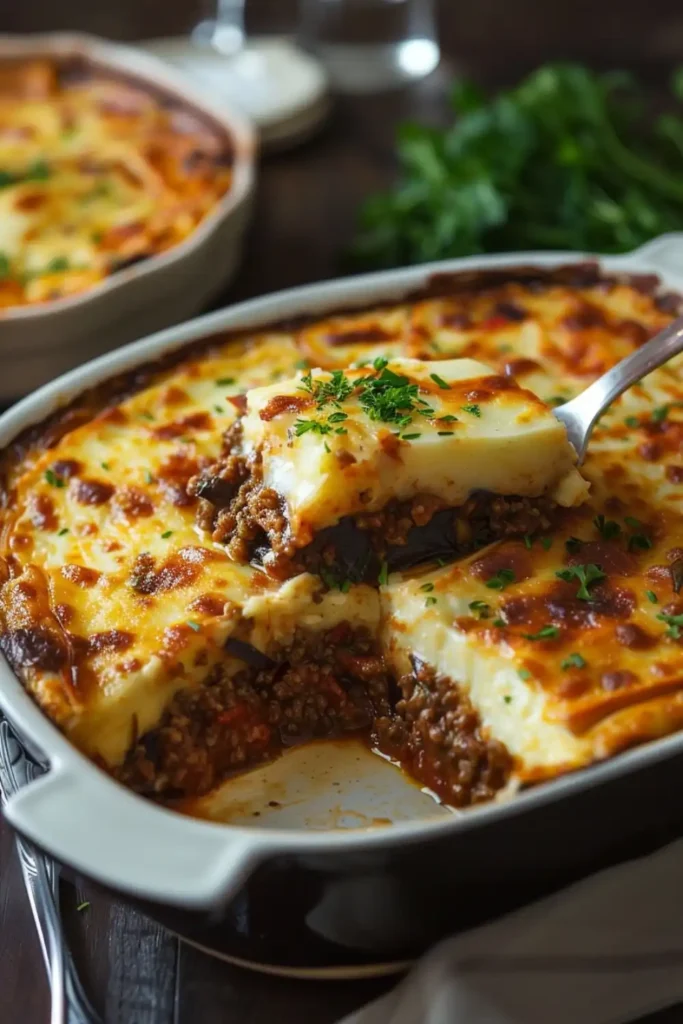

Authentic Greek Moussaka Recipe: A Step-by-Step Guide
- Total Time: 1 hour 30 minutes
- Yield: 6–8 servings 1x
- Diet: Vegetarian
Description
A classic Greek comfort dish made with layers of roasted eggplant, spiced meat sauce, and creamy béchamel. This authentic moussaka is rich, hearty, and perfect for family dinners or festive gatherings.
Ingredients
🧄 For the Eggplant Layer:
2–3 large eggplants (firm and glossy)
Salt (for drawing out moisture)
Olive oil (for roasting or frying)
🥩 For the Meat Sauce:
1 lb (450g) ground lamb or beef
1 medium onion, finely chopped
3 cloves garlic, minced
2 tbsp olive oil
2 tbsp tomato paste
1 cup crushed tomatoes
½ tsp ground cinnamon
¼ tsp ground allspice
1 tsp dried oregano
1 bay leaf
½ tsp sugar
Salt and pepper to taste
🥔 Optional Potato Base:
2–3 medium potatoes, peeled and sliced into ¼-inch rounds
Salt, olive oil (for boiling, roasting, or frying)
🧀 For the Béchamel Sauce:
4 tbsp butter
4 tbsp all-purpose flour
3 cups warm milk
¼ tsp ground nutmeg
½ cup grated Parmesan or Kefalotyri cheese
2 egg yolks (optional, for richness)
Salt and white pepper to taste
Instructions
👨🍳 Instructions:
Prepare the Eggplants
Slice eggplants into ½-inch rounds. Sprinkle with salt and let sit for 20–30 minutes to draw out bitterness. Pat dry. Brush with olive oil and roast at 400°F (200°C) for 20–25 minutes, flipping halfway, until golden and tender. Set aside.(Optional) Prepare the Potatoes
Peel and slice potatoes into ¼-inch rounds. Boil until just tender, about 5–7 minutes. Drain and set aside. You can also roast or lightly fry them for extra flavor.Make the Meat Sauce
In a skillet, heat olive oil over medium heat. Sauté onion and garlic until soft. Add ground meat and cook until browned. Stir in tomato paste, crushed tomatoes, wine (if using), cinnamon, allspice, oregano, bay leaf, and sugar. Simmer on low heat for 20–30 minutes until thickened. Season with salt and pepper. Remove bay leaf.Prepare the Béchamel Sauce
In a saucepan, melt butter over medium heat. Whisk in flour to make a roux. Gradually add warm milk, whisking constantly to avoid lumps. Cook until thick and creamy. Remove from heat and stir in grated cheese, nutmeg, salt, and white pepper. Let cool slightly, then whisk in egg yolks (if using).Assemble the Moussaka
Lightly grease a 9×13-inch baking dish. If using potatoes, layer them at the bottom. Add a layer of roasted eggplant, then spread half the meat sauce. Repeat layers with remaining eggplant and meat sauce. Pour béchamel sauce over the top, spreading evenly to the edges.Bake
Preheat oven to 375°F (190°C). Bake uncovered for 45–50 minutes, until the top is golden and bubbling. Let rest for 20–30 minutes before slicing to help the layers set.
- Prep Time: 40 minutes
- Cook Time: 50 minutes
- Category: Main Course
- Method: Baking
- Cuisine: Greek, Mediterranean
Nutrition
- Serving Size: 1 slice (1/8 of 9×13″ pan)
- Calories: ~450 kcal
- Sugar: 6g
- Sodium: 500mg
- Fat: 28g
- Saturated Fat: 12g
- Unsaturated Fat: 14g
- Trans Fat: 0.5g
- Carbohydrates: 25g
- Fiber: 5g
- Protein: 22g
- Cholesterol: 90mg

